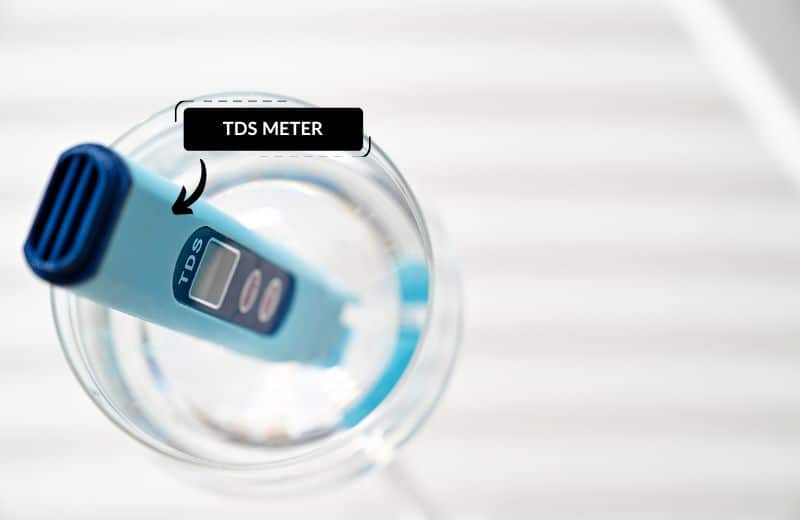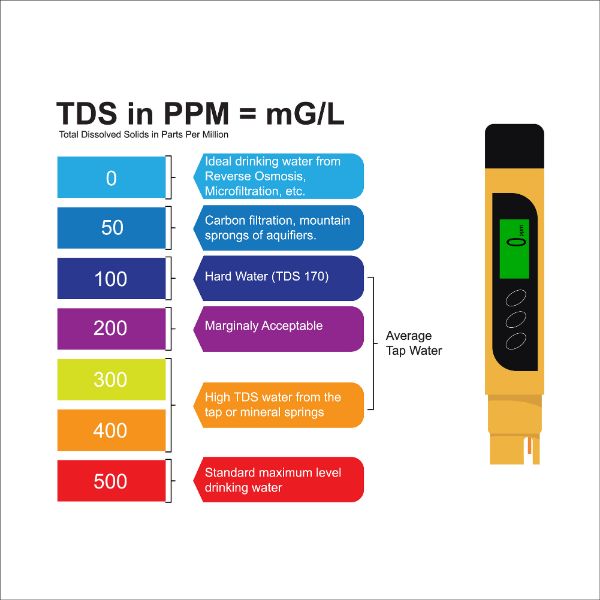If you’re keen to learn about the quality of your tap water, you may benefit from using a TDS meter.
But TDS meters might not produce the results you’re looking for.
It’s important to understand exactly how a TDS meter can be used – and the potential setbacks of using a TDS reader compared to other water quality indication methods.
This guide will teach you everything you need to know about total dissolved solids, using a TDS meter, and the benefits of measuring TDS. By the end, you will know whether using a TDS meter to test your water is the right choice for you.
Table of Contents
🔬 What is TDS (Total Dissolved Solids)?
TDS is a water quality parameter that measures the total concentration of total dissolved solids in your water. Some of the most common total dissolved solids in drinking water are inorganic materials, metals, ions, salts, natural pesticides, chemicals, compounds, and other dissolved substances.
TDS is an indication of water’s impurities – not necessarily its contaminants.
So, for instance, water may have an elevated TDS if it contains large quantities of healthy dissolved minerals, like magnesium, calcium, sodium, and chlorides.
You can learn more about total dissolved solids, and check out my list of the most common TDS, in this guide 👈
📊 What is a TDS Meter?
A TDS meter is a portable device that is used to measure the level of TDS in a water source.
TDS meters measure total dissolved solids in PPM (parts per million) or mg/L (milligrams per liter). Both measurements are the same, and are often used interchangeably.
A TDS meter measures the conductivity of a solution. Dissolved ionized solids, like minerals and salts, increase water’s conductivity. Therefore, a higher conductivity reading indicates a higher TDS level.
You can buy a TDS meter for less than $10, but these devices can cost in the hundreds. It all depends on the features you’re looking for and the level of accuracy you want from testing.

⚙️ How Does a TDS Meter Work?
Digital TDS meters are very easy to use. Simply fill a glass of tap water and switch the TDS meter on. Place the digital device into your water sample and wait for a measurement to appear on the screen. It takes only seconds for a TDS meter to determine the conductivity of your water, and the total dissolved solids present.
Depending on the type of TDS meter you own, you might need to press a button to keep the reading in place before removing the reader from your water sample.
The screen will show a reading in PPM (parts per million) or mg/L (milligrams per liter). If the reading comes back at 200 or less, it’s considered acceptable. If your tap water TDS reads less than 300 PPM, it’s average. If the TDS meter indicates a TDS of between 300 and 500 PPM, it’s considered high.
Readings above 500 indicate that your TDS is higher than the maximum contaminant level (MCL) set by the EPA and is considered hazardous.

❗️ What Does a TDS Meter NOT Measure?
Before purchasing a TDS meter, it’s important that you understand what it doesn’t test for.
Parameters that a TDS reader can’t measure are:
Contaminants
A TDS meter doesn’t show what contaminants are actually in the water. While a TDS meter will indicate the quantity of total dissolved solids in your water in PPM, it won’t tell you precisely what these solids are.
Too often I see people mistaken on this point. Take note!
Water Health
An elevated TDS reading doesn’t automatically imply that your water is unhealthy. Your water could contain healthy dissolved minerals, like calcium, magnesium and potassium, that are contributing to its high TDS reading. You might not have any harmful contaminants in your water, even with elevated TDS.
Even bottled water doesn’t have a low TDS, unless you purchase water that has been treated with RO water filtration.
Filtration Effectiveness
TDS meters can only measure the effectiveness of filters that are designed to remove TDS from water, such as reverse osmosis filters. While other filters might have a small impact on TDS, it’s unlikely that they will make much of a change to your reading overall.
It’s not advisable to use a TDS meter to determine whether a standard water filter works.
Specific Metals & Chemicals
A TDS meter is only capable of measuring dissolved solids, which means that certain contaminants, like lead, pharmaceuticals, some pesticides and chromium-6 might not be detected by the reader.
Hopefully, you can understand from the above list why you shouldn’t use a TDS meter to measure for contaminants or even determine whether your water quality is “good” or “bad”.
If you are going to use a TDS meter, it’s best using it alongside a water testing kit that measures for specific contaminants, so you have a clearer idea of what you’re dealing with.
| Measurement | Measured by a TDS Meter |
|---|---|
| Conductivity | ✔️ |
| Concentration of Dissolved Solids | ✔️ |
| Contaminants Present | ❌ |
| If Water is Healthy or Not | ❌ |
| Filter Effectiveness | ❌ |
| Specific Metals & Chemicals | ❌ |
🤔 Why Should I Measure TDS in Drinking Water?
If your drinking water has a high TDS level, it means it contains an elevated quantity of dissolved solids (including salts and minerals). A high TDS, regardless of the exact contaminants your water contains, usually results in damage to your home’s pipes from scale build-up.
Knowing the TDS level of your drinking water means you can determine whether you should take action to combat a scale problem. For instance, you might decide to purchase a salt-based water softener or salt-free conditioner to prevent scale formation and the costly damage it can cause.
Water softeners tackle hard water issues head-on by removing calcium & magnesium, the two minerals responsible for limescale deposits. This protects your plumbing, increases the lifespan of your appliances, and decreases stains and spots on glassware.
An alternative to a water softening system is a water conditioner, which, rather than removing calcium and magnesium dissolved in water, simply prevents the minerals from sticking to surfaces. The advantage here is that that you can still drink these healthy minerals in your water.
📷 How Can I Get the Full Picture of My Water Quality?
To gain a proper understanding of your water quality, I recommend taking the following action:
Check Your Local Water Quality Report
First, a free and easy option is to obtain a water quality report from your water supplier. This report will list exactly which contaminants are present in your public water supply, and to what level (measured in PPM, or parts per million).
Water treatment centers are obliged by the EPA to remove specific harmful contaminants to below the EPA’s Maximum Contaminant Level, but there might still be contaminants listed in your report that are causing an increase in your tap water TDS.
Water quality reports are available to the public for free viewing. If you can’t find your local WQR online, contact your water supplier for an email copy.
Learning what’s in your water will help you to decide whether your health or home would benefit from a water filtration system.
Test Your Water
The second option is to test your water.
I recommend doing this if you want clarification of the data on your water quality report, you’re testing for a contaminant that might leach into your tap water after treatment, or you get your water from a private well.
You can choose to test your water with an at-home testing kit or through an independent testing laboratory.
At-home testing kits are handy for getting a rough idea of what contaminants are in your water. These tests typically cost less than $20 and can test for a range of common drinking water quality and taste factors, including hardness, pH, chlorine, lead, iron, pesticides, bacteria, and nitrates.
While at-home testing isn’t quite as thorough as laboratory testing, it can give you a good indication of which contaminants might be affecting your water TDS levels.
Arranging for a laboratory to test your tap water will offer you the most detailed, comprehensive results. Laboratory testing can break down precisely what is in your water, and how each of these impurities correlates to your water TDS levels.
You can choose from specific testing packages, depending on whether you’re testing well water or public water, and whether there are any specific impurities you’re concerned about. This will give you a clear idea of whether you could benefit from using any filtered water systems in your home.
I recommend Tap Score by Simple Lab as the best, most comprehensive lab testing available in 2024.

🤷♂️ So, Do I Need a Water Filter if my Water’s TDS Reading is High?
In summary, TDS is simply a measurement of how many dissolved solids are in your water, and can’t determine whether you’re dealing with any harmful contaminants.
While your TDS level gives an indication of whether you’ll need a water softener or conditioner, it can’t be used alone to determine whether you need a water filter.
A TDS tester can be handy for getting a vague idea of water quality. You might also benefit from using a TDS water meter to check that a reverse osmosis system is working.
High TDS may affect your water in a number of ways. For example, elevated TDS may give your water a bad taste, but it may also make your water taste alkaline, like bottled water. Elevated TDS may also indicate that harmful impurities are present in your water, such as lead. Equally, a high TDS reading may simply be caused by an elevated concentration of healthy minerals.
Keep in mind that, if you do need a water filter, removing all TDS is not necessarily the solution you should aim for. Many total dissolved solids are healthy minerals that improve water taste and are related to alkalinity. It’s common for low TDS to cause issues with acidity, which can make your water more prone to heavy metal leaching.
If your goal is to remove the most unhealthy impurities, while retaining the healthy minerals in your drinking water, consider reverse osmosis filtration. I would advise looking at RO systems that use remineralization filters, as these will remove the majority of TDS before reintroducing healthy mineral ions into your water. This will essentially give you bottled water quality and taste from your faucet.
Of course, if you’re not interested in achieving a low TDS, and you’d rather focus on contaminant removal, you have plenty of other filtration systems to consider. A whole-home filter, an under-sink filter or a countertop filter can improve the taste of your water and remove common impurities like chlorine and lead.
